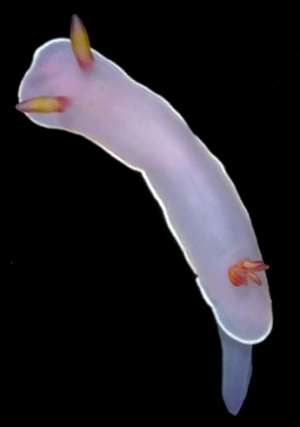
Thorunna punicea
(Rudman, 1995)
Order: NUDIBRANCHIA
Suborder: DORIDINA
Superfamily: EUDORIDOIDEA
Family: Chromodorididae
DISTRIBUTION
Known only from New Caledonia
PHOTO
Upper right: Channel, Passe de Koumac, 20 40.7'S, 164 14.7'E, 66-87m, dredged in mixed shell sand and mud, NW New Caledonia, HOLOTYPE, 12mm long alive, 24 October 1993, AM C200618 (in MNHN, Paris). Photo: Bill Rudman. Lower: SEM photos of the radula. A, Central region of radula showing Thorunna-like tricuspid innermost lateral teeth. B. Section of radula showing inner half of left side. Note bicuspid Hypselodoris-like lateral teeth. C, jaw rodlets. Passe de Koumac, New Caledonia, 12mm long alive, (AM C200618). Scale bars = 25 µm. Photo: A.C. Miller.
The mantle is a bluish purple with a pinkish tinge anteriorly, between the rhinophores. There is a thin opaque white line right at the mantle edge. The rhinophore stalk is wine-red, the colour diffusing on the basal part of the club. The rest of the rhinophore club is yellow except for the upper few lamellae which are purplish red. The knob at the tip of the rhinophore is translucent clear. The simple gills are translucent clear with a yellowish tinge. The line along the outer edge of each gill is orange on the basal half, and red on the upper half. The line along the inner edge of each gill is red. The change from orange to red along the outer edge is very diffuse. The foot and underside of the body is a uniform bluish purple, somewhat darker than that of the mantle.
The mantle is elongately oval, somewhat broader anteriorly, giving the body a spatula-like shape. The body is relatively high and the mantle overlap not greatly developed into a skirt. It has similarities in shape to species of Hypselodoris and Risbecia. There are no signs of mantle glands. There are eight simple gills arranged in a circlet, open posteriorly, around the anus. The two most posterior gills are smaller than the others. The gills vibrate rhythmically as the animals crawls along.
When I described this species there were a number of puzzling anatomical features which suggested that the species was not a species of Hypselodoris but perhaps a species of Thorunna or even Durvilledoris. In particular, features of the reproductive system, the absence of mantle glands and vibratile gills were all characteristic of Thorunna. The innermost lateral teeth are also quite characteristic of Thorunna. In Gosliner & Johnson's review (1999) of Hypselodoris, this species is moved to Thorunna, a decision which I fuller agree with.
-
Gosliner, T.M. & Johnson, R.F. (1999) Phylogeny of Hypselodoris (Nudibranchia: Chromodorididae) with a review of the monophyletic clade of Indo-Pacific species, including descriptions of twelve new species. Zoological Journal of the Linnean Society, 125: 1-114.
-
Rudman, W.B. (1995) The Chromodorididae (Opisthobranchia: Mollusca) of the Indo-West Pacific: further species from New Caledonia and the Noumea romeri colour group. Molluscan Research, 16: 1-43.
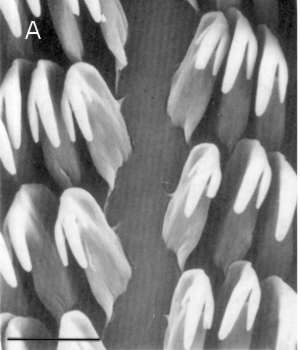
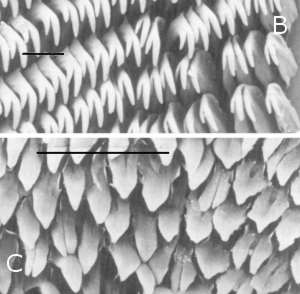
Rudman, W.B., 2005 (February 1) Thorunna punicea (Rudman, 1995). [In] Sea Slug Forum. Australian Museum, Sydney. Available from http://www.seaslugforum.net/find/thorpuni
Related messages
Thorunna punicea again [2]
April 25, 2008
From: Colin Ogden

Dear Bill,
I was very excited when I found the Thorunna punicea a couple of days ago [message #20671]. We have now found another one today. This was also on a totally different reef from the 3 other ones. This time it was moving across the reef, and not only did it have the rhythmical moving of it gills, it also was lifting the front edge of its mantle, very much like the Chromodoris conchyliata. I don't know whether this is normal behaviour, but thought you might be interested.
Once again its colour coding is identical to the previous ones. I know I at first thought it might be a H. bullocki, but most pictures I have seen of the H. bullocki have the gills situated almost at the end of an extended stalk.
Valda Fraser in the book she published with Dennis King (More Reef Fishes and Nudibranchs) also has an identical animal shown as a H. bullocki. Maybe the T. punicea has been around here for a lot longer than we know, and also now found on 4 separate reefs, maybe it has established a breeding base.
Locality: Sodwana Bay, 10 metres, South Africa, Indian, 12 September 2007, Reef. Length: 50mm. Photographer: Colin Ogden.
PS: thanks so much for the response on the Cerberilla africana [message #20692]. I shared it with Greg and he was very excited about it.
Regards
Colin
scubaco@iafrica.com
Ogden C. M., 2008 (Apr 25) Thorunna punicea again [2]. [Message in] Sea Slug Forum. Australian Museum, Sydney. Available from http://www.seaslugforum.net/find/20715Dear Colin,
Thanks for this. You comment about the gills being on a 'stalk' in H. bullocki is quite correct. This difference certainly supports the idea that your animals are not H. bullocki. It would certainly be good to check the the anatomy of your animals.
Best wishes,
Bill Rudman
Thorunna punicea again [1]
April 25, 2008
From: Colin Ogden
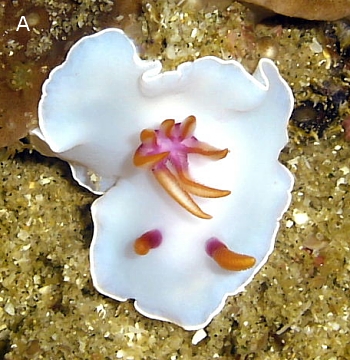
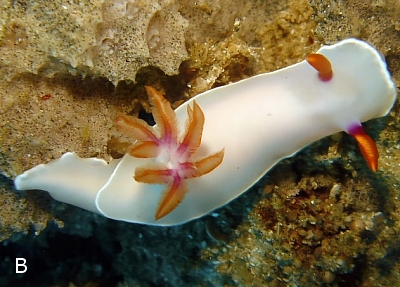
Dear Bill,
At last another Thorunna punicea. Photos A and B we have already discussed, but photo C is the new one. Obviously these nudis are very rare here, but they have been on 3 different reefs over a period of over 2 years.
Locality: Sodwana Bay, 21 metres, South Africa, Indian, 06 September 2007, Reef. Length: 45 mm. Photographer: Colin Ogden.
A. Ribbon reef 22nd July 2005
B. Bikini reef 10th November 2006
C. Fusilier reef 6th September 2007
One thing that I find remarkable about this nudi is the colour scheme is always the same.
The consistant factors are: Winter or early summer when our water temperature is relatively cold, between 22 and 23 degrees centigrade.
The reefs are not just coral, but a fairly proportionate mixture of coral and sponge. All at a depth of 18 to 21 metres
I don't know whether the above is of any significance, but I will keep looking to see if we get a consistent pattern.
Regards
Colin
scubaco@iafrica.com
Ogden C M, 2008 (Apr 25) Thorunna punicea again [1]. [Message in] Sea Slug Forum. Australian Museum, Sydney. Available from http://www.seaslugforum.net/find/20671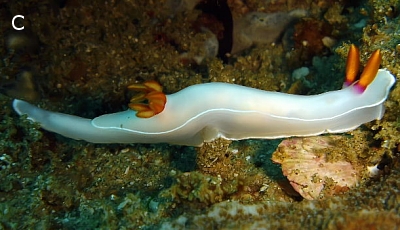
Dear Colin,
Thanks for keeping this in mind. It is possible the animal in Photo A just appears to have a much wider Chromodoris -like mantle skirt. Apart from looking at their anatomy one thing you could look out for is what they eat. The animal in Photo B, eats a species of Dysidea, which is illustrated in an earlier message [#19739] with a rather characteristic skeleton embedded with sandgrains [you can also see a bit of it at the top left of Photo B]. If the animal in Photo A is different it may show this by feeding on a quite different sponge, as species of Chromodoris and most Noumea don't feed on dysideid sponges. But as you already know it's not always an easy task to find what they feed on
Best wishes,
Bill Rudman
Re: Thorunna punicea? from South Africa
March 22, 2007
From: Colin Ogden
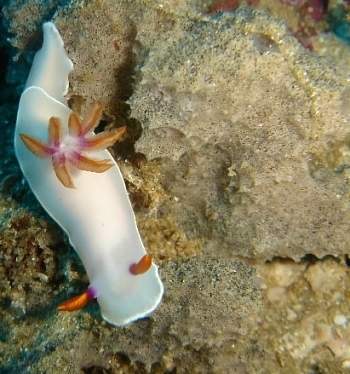
Concerning message #19718:
Dear Bill,
I do have some better pictures of the sponge and one pic that shows more evidence of feeding. I hope these will be clear enough. I have had a closer look at the pictures of the more flattened animal in my original message and they do suggest that the gills are waving in clockwise and anticlockwise directions. This at first I thought was a result of the surge.
Locality: Sodwana Bay, 22 metres, South Africa, Indian, Oct 2006, reef. Length: 25mm. Photographer: Colin Ogden.
Regards
Colin
scubaco@iafrica.com
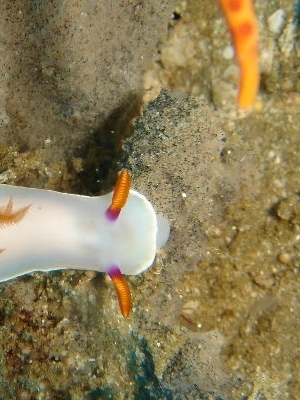
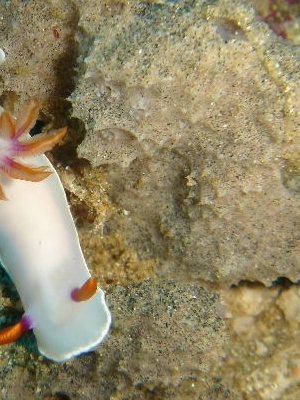
Thanks Colin,
Yes this is definitely a sponge. When I first looked I thought it was an irciniid, which are a family of sponges which often incorporate sand grains in their structure, but looking more closely at places where the slug seems to have been eating, it looks like the sponge is only a very thin layer over the underlying rock. The sponge is almost transparent so the sandy rock shows right through the sponge tissue. I am pretty sure the sponge is a species of Dysidea, which is a nice find as we have no other record of this species feeding.
Best wishes,
Bill Rudman
Re: Thorunna punicea? from South Africa
March 21, 2007
From: Colin Ogden
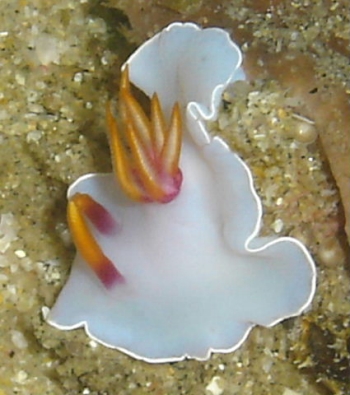
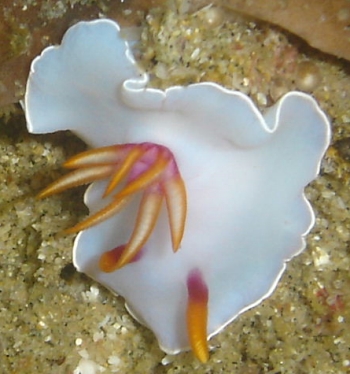
Concerning message #19708:
Dear Bill,
Thanks for the response on the Thorunna punicea. I do not recall the nudibranch waving the edges of its mantle, but I did take 9 pictures of it and I am sending a copy of the first pic I took and the last pic (from a different angle). They all seem to have the same comsistent folds. It was stationary and not moving at all. I am also sending a picture of a nudi that I have also identified as a H. bullocki found on a different reef, but now I have doubts and it might also be a T. punicea.
Locality: Sodwana Bay, 19 metres, South Africa, Indian, July 2005, reef. Length: 20mm. Photographer: Colin Ogden.
Regards
Colin
scubaco@iafrica.com
Ogden C. M., 2007 (Mar 21) Re: Thorunna punicea? from South Africa. [Message in] Sea Slug Forum. Australian Museum, Sydney. Available from http://www.seaslugforum.net/find/19718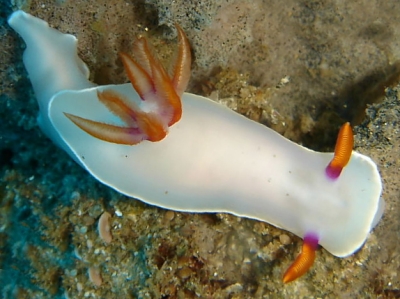
Dear Colin,
The animal in your lower photo does look like H. bullocki, and seems to have a narrower mantle than your first animal, but it would be a remarkable example of colour mimicry if the two were different. Of course I can't be sure that they are Thorunna punicea without some anatomical information, but I think that is the 'best guess' at present.
Concerning 'waving' - what I asked was did the gills wave, not the mantle. Most species of Thorunna have gills which rhythmically wave clockwise then anticlockwise in unison. The other thing I noticed in your lower photo is that the buccal bulb seems to be everted suggesting the animal is feeding. I suspect quite a bit of the background is a greyish brown sponge but I cant see it clearly enough. Its almost impossible the get both a slug and the background in focus at this magnification, but perhaps you have a photo in which the background is more in focus than the slug. If so it would be intersting to have a look at it
Best wishes,
Bill Rudman
Thorunna punicea? from South Africa
March 19, 2007
From: Colin Ogden
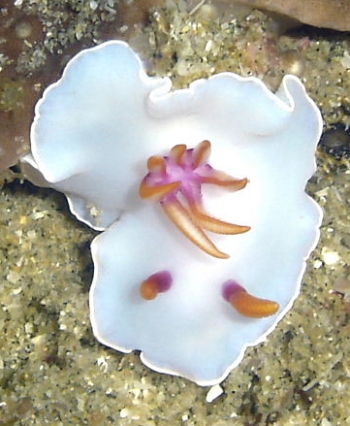
Concerning message #19608:
Hi Bill,
I noticed on your reply to Richard Ling's message that you mentioned the high body profile of Hypselodoris bullocki, and I have checked in all the books I have with pictures of H. bullocki and they all conform to that description. I have this picture taken quite a few years ago of what I have thought was a H. bullocki, but it is showing a very flattened body. Have I mistaken the identity, or is it doing something unusual?
Locality: Sodwana Bay, 19 metres, South Africa, Indian, july 2005, reef. Length: 20mm. Photographer: Colin Ogden.
Your comments would be greatly appreciated.
regards
Colin Ogden
scubaco@iafrica.com
Ogden C. M., 2007 (Mar 19) Thorunna punicea? from South Africa. [Message in] Sea Slug Forum. Australian Museum, Sydney. Available from http://www.seaslugforum.net/find/19708Dear Colin,
I am very pleased you decided to check up on this animal. I agree it is not H. bullocki, although the purple bases to the rhinophores and gills are reminiscent of that species. However I think your animal is a species with a similar colour pattern, Thorunna punicea, which is known at present only from New Caledonia. Unfortunately we know very little about the species, and the only known specimen had a purplish background colour. However in your photo there are traces of a purplish colouration on the inside edge of the opaque white mantle border. The only way to be sure would be to look at the anatomy of your South African animal. One other distinctive feature was that it 'wiggled' its gills from side to side as it crawled along. I don't suppose you would remember if it did that? However in your photo I get the impression the gills are in motion, so my best bet is that this is Thorunna punicea - or a close relative.
Best wishes,
Bill Rudman
